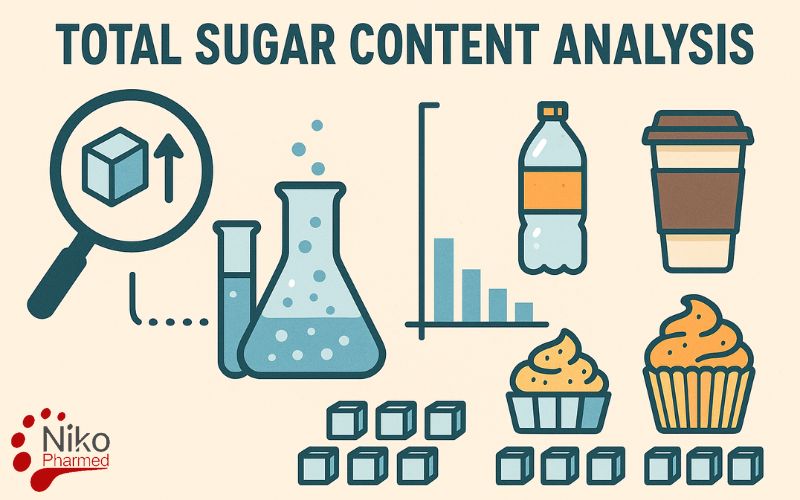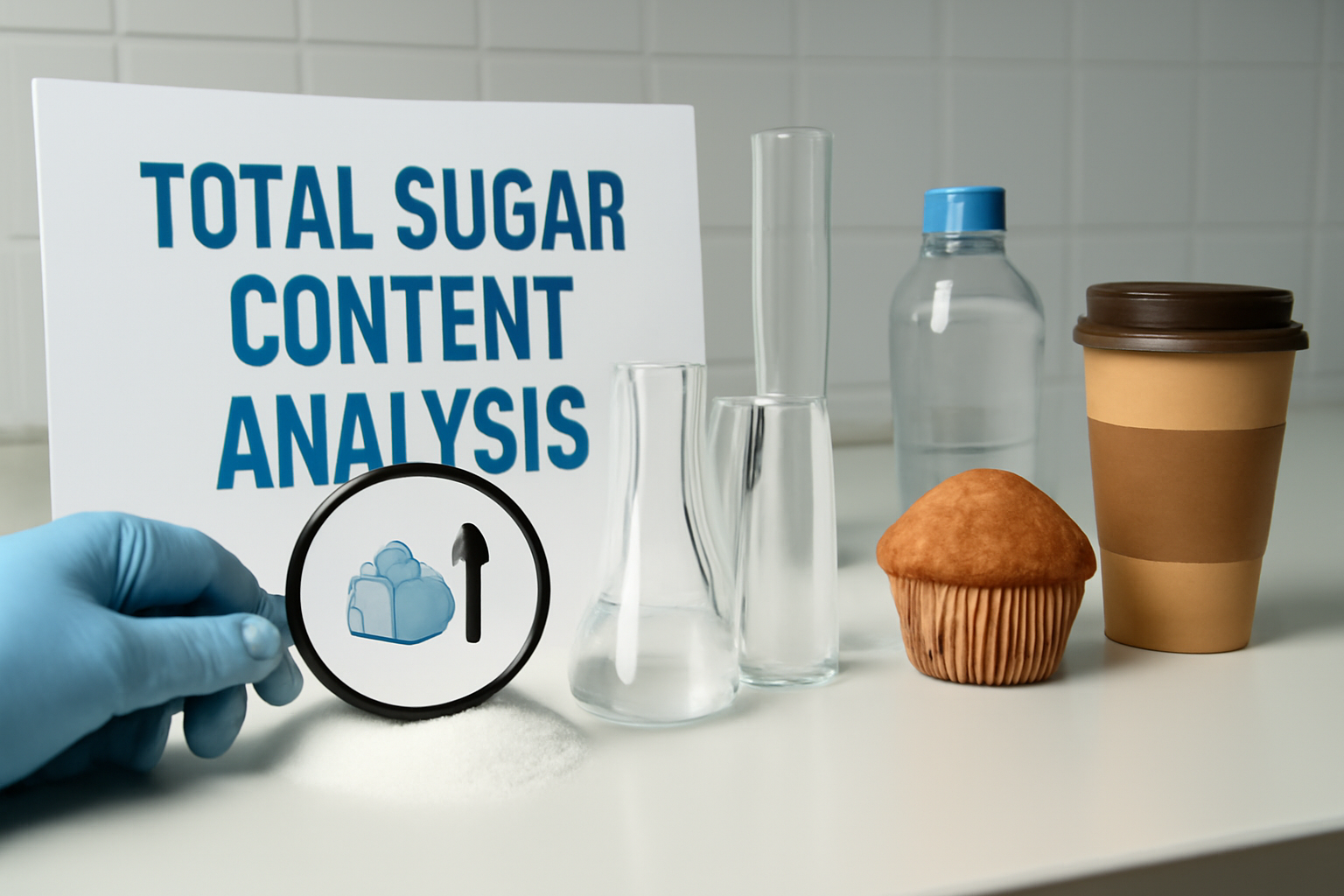What is Total Sugar Content Analysis?
Total Sugar Content Analysis is the process of determining the overall amount of sugars naturally present or added to a food or beverage product, expressed as the combined concentration of all simple carbohydrates such as monosaccharides and disaccharides.
This analysis provides a clear and standardized measure of the sweetness-contributing components within a product, offering critical information for nutritional labeling, dietary assessment, and regulatory compliance. These tests are often conducted alongside Moisture Content Analysis to express results on a dry-matter basis.
By quantifying the total sugars, the analysis supports transparency for consumers, ensures that manufacturers meet established nutritional standards, and allows for consistent comparison of products across markets in line with international food regulations.
Total Sugar Content Analysis Test Methods
Enzymatic Methods
Enzymatic methods use highly specific enzymes to target and quantify individual sugars or total sugars. For example, invertase hydrolyzes sucrose into glucose and fructose, and glucose oxidase catalyzes the oxidation of glucose to gluconic acid and hydrogen peroxide, which can be measured colorimetrically or fluorometrically.
These reactions are highly selective, reducing the risk of interference from other compounds. Because they rely on specific biochemical conversions, enzymatic methods are widely recognized for their precision in nutritional analysis and are commonly used in standardized protocols.
In routine food and nutraceutical testing, enzymatic sugar assays are frequently combined with Carbohydrate Analysis and Sucrose Analysis to differentiate individual sugars and confirm total sugar declarations on nutrition labels.
Spectrophotometric Methods
Spectrophotometric techniques rely on chemical reactions that produce a color change proportional to sugar concentration. A common example is the anthrone method, where sugars react with anthrone reagent under acidic conditions to yield a green-blue complex measurable at 620 nm.
Similarly, the DNS (3,5-dinitrosalicylic acid) method measures reducing sugars by producing a colored compound upon reduction. These methods are relatively simple and cost-effective, making them useful for total sugar estimation in research and quality control. However, they lack specificity, as other reducing compounds may interfere with absorbance readings.
In practice, these colorimetric reactions are monitored using calibrated Ultraviolet–Visible Spectroscopic (UV–Vis) instruments, allowing absorbance to be measured at the specific wavelengths required by each method.
High-Performance Liquid Chromatography (HPLC)
HPLC is one of the most robust and precise techniques for sugar analysis. It separates sugars based on their polarity and molecular structure using specialized chromatographic columns (such as ion-exchange or carbohydrate-specific columns). Detection is typically achieved with a refractive index (RI) detector, pulsed amperometric detection (PAD), or UV detection after derivatization.
HPLC allows the quantification of individual sugars (glucose, fructose, sucrose, lactose, maltose, etc.) and is considered the gold standard in many international standards due to its accuracy, reproducibility, and ability to handle complex food matrices. However, it requires expensive equipment and technical expertise.
Titrimetric Methods (Lane-Eynon and Fehling’s Test)
Titrimetric methods rely on the reducing properties of sugars. In the Lane-Eynon method, reducing sugars reduce copper(II) ions from a standard Fehling’s solution to insoluble copper(I) oxide under heat. The endpoint is detected by a color change using an internal indicator (such as methylene blue).
This method is one of the oldest and simplest ways to quantify sugars, particularly in traditional food industries. However, it is limited to reducing sugars and requires a prior hydrolysis step to measure non-reducing sugars like sucrose. Its main drawbacks are low precision, operator dependency, and susceptibility to matrix interferences.
Comparative Summary of Test Methods
| Method | Scientific Principle | Advantages | Limitations |
|---|---|---|---|
| Enzymatic Analysis | Specific enzymes hydrolyze/oxidize sugars; reaction products quantified by colorimetric/fluorometric measurement. | High specificity, accurate for individual sugars, widely used in standards. | Costly reagents, requires precise conditions, limited sugar coverage without multiple enzymes. |
| Spectrophotometry | Sugars react with chromogenic agents (e.g., anthrone, DNS), forming colored complexes measurable at specific wavelengths. | Simple, inexpensive, rapid for total sugars. | Non-specific, interference possible, moderate sensitivity. |
| HPLC | Separation of sugars via chromatographic column; quantification by RI, PAD, or UV detection. | Highly precise, identifies and quantifies individual sugars, reproducible, gold standard. | High cost, time-consuming, requires technical expertise. |
| Titrimetric (Lane-Eynon) | Reducing sugars reduce Cu(II) to Cu(I) under heat, endpoint detected by indicator color change. | Very simple, inexpensive, minimal equipment required. | Low accuracy, subjective endpoint detection, limited to reducing sugars unless hydrolysis is performed. |
Nikopharmed Total Sugar Content Analysis
Laboratory Accreditation and Global Recognition
At Nikopharmed, our Total Sugar Content Analysis services are performed under ISO/IEC 17025 certification and ILAC accreditation, ensuring adherence to globally recognized standards of analytical quality and technical competence.
Technical Excellence and Validated Infrastructure
Our laboratory is equipped with advanced polarimetric systems, high-performance liquid chromatography (HPLC) with multiple detection options, and enzymatic platforms for precise sugar profiling in complex matrices.
Supported by automated sample preparation, validated extraction systems, and precision balances, we deliver accurate total sugar content analysis across diverse products, including raw materials, refined sugars, beverages, dairy, confectionery, pharmaceuticals, and nutritional supplements.
Regulatory-Ready Reporting and Timely Results
In industries where compliance deadlines are critical, Nikopharmed provides fast, accurate, and defensible total sugar content results.
Our optimized workflow guarantees rapid turnaround without compromising analytical rigor or compliance, supporting quality assurance programs, product certification, import/export inspections, and label claim verification.
Confidentiality and Data Integrity
All analyses are conducted under legally binding non-disclosure agreements (NDAs), ensuring proprietary formulations, research data, and regulatory submissions are handled with complete professionalism. Every test result is documented with a full audit trail to maintain traceability, reliability, and transparency.
Competitive Pricing with Uncompromised Quality
Nikopharmed offers cost-effective total sugar analysis solutions tailored to the needs of small enterprises, multinational corporations, and regulatory agencies. Our transparent pricing allows clients to meet international compliance standards efficiently, accelerating regulatory approvals while maintaining uncompromising analytical precision and reliability.
To request testing or a complimentary consultation contact Nikopharmad
Partner with Nikopharmed for Expert Total Sugar Content Analysis
By choosing Nikopharmed, you access a globally accredited laboratory committed to scientific excellence, regulatory compliance, and absolute data confidentiality. Whether ensuring product consistency, verifying nutritional labeling, meeting import/export requirements, or satisfying strict industry standards, our total sugar content analysis expertise guarantees accurate, reliable, and internationally recognized results—helping you achieve compliance with confidence.


